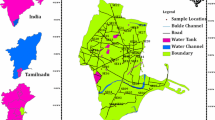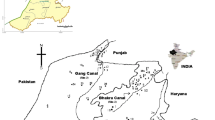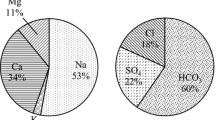Abstract
As in many districts in Tamil Nadu, Vellore has a long tradition and culture in agriculture. However, the stress on the existing water resources have reduced the availability and deteriorated the quality of water used in irrigation. Present study attempted to assess the hydrochemistry in order to evaluate the quality of water used for irrigation in and around Vaniyambadi tannery cluster in the Vellore district. Results show that the groundwater in the study area remains alkaline throughout the year. The dominance of major cations and anions in the groundwater were in the order of Na+ > Mg2+ > Ca2+ > K+ and Cl− > HCO3 − > SO4 2− > CO3 2− respectively. This was in agreement with major water types (Na–Cl) observed in the piper plot. A detailed analysis of the hydrochemical data show that tannery effluent, silicate weathering and ion exchange processes are the major factors influencing hydrogeochemical characteristics of the groundwater. Results of the chloro-alkaline indices confirmed that reverse ion exchange process is a prominent process controlling Ca2+and Na2+ ion concentrations in the study area. Sodium percentage, sodium adsorption ratio, residual sodium carbonate, permeability index, magnesium ratio and Kelly index were calculated for the groundwater samples. Excluding the magnesium hazard, other parameters showed that the water quality is permissible for irrigation purposes.





Similar content being viewed by others
References
Nickson RT, McArthur JM, Shrestha B, Kyaw-Nyint TO, Lowry D (2005) Arsenic and other drinking water quality issues, Muzaffargarh District, Pakistan. Appl Geochem 20:55–68
Mondal NC, Saxena VK, Singh VS (2005) Assessment of groundwater pollution due to tannery industries in and around Dindigul, Tamilnadu, India. Environ Geol 48:149–157
Ketata M, Gueddari M, Bouhlila R (2011) Suitability assessment of shallow and deep groundwaters for drinking and irrigation use in the El Khairat aquifer (Enfidha, Tunisian Sahel). Environ Earth Sci. doi:10.1007/s12665-011-1091-z
Subramani T, Elango L, Damodarasamy SR (2005) Groundwater quality and its suitability for drinking and agricultural use in Chithar River Basin, Tamil Nadu, India. Environ Geol 47:1099–1110
Naseem S, Ahmed P, Shamim SS, Bashir E (2011) Geochemistry of sulphate-bearing water of Akra Kaur Dam. Environ Earth Sci, Gwadar. doi:10.1007/s12665-011-1408-y
Ako AA, Shimada J, Hosono T, Ichiyanagi K, Nkeng GE, Fantong WY, Eyong GET, Roger NN (2011) Evaluation of groundwater quality and its suitability for drinking, domestic, and agricultural uses in the Banana lain (Mbanga, Njombe, Penja) of the Cameroon Volcanic line. Environ Geochem Health 33:559–575
Zhang DD, Zhang M (2006) Assessing the impact of leather industry to water quality in the Aojing watershed in Zhejiang Province, China. Environ Monit Assess 115:321–333
Simsek C, Gunduz O (2007) IWQ Index: a GIS-integrated technique to assess irrigation water quality. Environ Monit Assess 128:277–300
CGWB (2009) District groundwater brochure Cuddalore district. Tech Report Ser, Tamil Nadu
APHA (1995) Standard methods for the examination of water and wastewater, 19th edn. American Public Association, Washington, p 1467
WHO (1993) Guidelines for drinking-water quality, vol 2–health criteria and other supporting information, and Vol 3–drinking-water quality control in small community supplies
Prasanna MV, Chidambaram S, Hameed AS, Srinivasamoorthy K (2010) Study of evaluation of groundwater in Gadilam basin using hydrogeochemical and isotope data. Environ Monit Assess 168:63–90
Sajil Kumar PJ, Jose A, James EJ (2013) Spatial and Seasonal variation in groundwater quality in parts of Cuddalore District, South India. Natl Acad Sci Lett 36:167–179
Rajmohan N, Elango L (2006) Hydrogeochemistry and its relation to groundwater level fluctuation in the Palar and Cheyyar river basins, southern India. Hydrol Process 20:2415–2427
Brindha K, Elango L (2012) Impact of tanning industries on groundwater quality near a Metropolitan City in India. Water Resour Manag 26:1747–1761
Piper AM (1953) A graphic procedure for the geo-chemical interpretation of water analysis. USGS Groundw 12:63
Sami K (1992) Recharge mechanisms and geochemical processes in a semi-arid sedimentary basin, Eastern Cape, South Africa. J Hydrol 139:27–48
Subramani T, Rajmohan N, Elango L (2010) Groundwater geochemistry and identification of hydrogeochemical processes in a hard rock region, Southern India. Environ Monit Assess 162:123–137
Schoeller H (1967) Qualitative evaluation of groundwater resources. Methods and techniques of water investigation and development. Water Resour UNESCO 33:44–52
Sajil Kumar PJ (2012) Assessment of Fluoride Contamination in Groundwater as Precursor for Electrocoagulation. Bull Environ Contam Toxicol 89:172–175
Ravikumar P, Somashekar RK, Angami M (2011) Hydrochemistry and evaluation of groundwater suitability for irrigation and drinking purposes in the Markandeya River basin, Belgaum District, Karnataka State, India. Environ Monit Assess 173:459–487
Ragunath HM (1987) Groundwater. Wiley Eastern Ltd., New Delhi, p 563
Wilcox LV (1948) The quality of water for irrigation use. U.S. Department of Agriculture, Technical Bulletin. Washington, DC: American Public Association, 962(40)
Wilcox LV, Blair GY, Bower CA (1954) Effect of bicarbonate on solubility of water for irrigation. Soil Sci 77:259–266
Todd DK (1969) Ground water hydrology. John Wiley, New York
U.S Salinity Laboratory Staff (1954) Diagnosis and improvements of saline and alkali soils. US Department of Agricultural soils. US Department of Agricultural Hand Book 60, Washington
Manish Kumar M, Kalpana K, Ramanathan AL, Rajinder S (2007) A comparative evaluation of groundwater suitability for irrigation and drinking purposes in two intensively cultivated districts of Punjab, India. Environ Geol 53(3):553–574
Vasanthavigar M, Srinivasamoorthy K, Prasanna MV (2012) Evaluation of groundwater suitability for domestic, irrigational, and industrial purposes: a case study from Thirumanimuttar river basin, Tamilnadu, India. Environ Monit Assess 184:405–420
Domenico PA, Schwartz FW (1990) Physical and chemical hydrogeology. Wiley, New York, pp 410–420
Kelly WP (1940) Permissible composition and concentration of irrigated waters. In: Proceedings of the ASCF66. p 607
Karanth KR (1987) Ground water assessment, development and management. Tata McGraw Hill Publishing Company Ltd., New Delhi, p 720
Gowd SS (2005) Assessment of groundwater quality for drinking and irrigation purposes: a case study of Peddavanka watershed, Anantapur District, Andhra Pradesh, India. Environ Geol 48:702–712
Szabolcs I, Darab C (1964). The influence of irrigation water of high sodium carbonate content of soils. In: Proceedings of 8th international congress of Isss, Trans, II: 803–812
Author information
Authors and Affiliations
Corresponding author
Rights and permissions
About this article
Cite this article
Sajil Kumar, P.J., Delson, P.D. & James, E.J. Evaluation of Groundwater Chemistry in Vaniyambadi Industrial Area with Special Reference on Irrigation Utility. Natl. Acad. Sci. Lett. 37, 493–502 (2014). https://doi.org/10.1007/s40009-014-0266-z
Received:
Revised:
Accepted:
Published:
Issue Date:
DOI: https://doi.org/10.1007/s40009-014-0266-z




